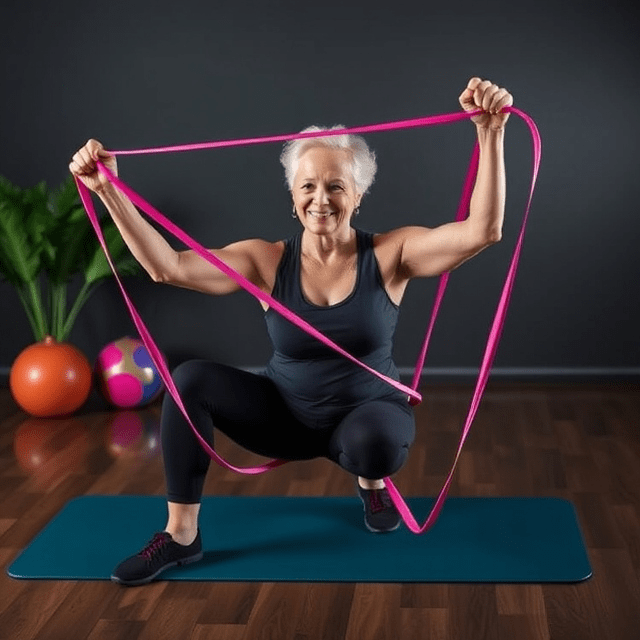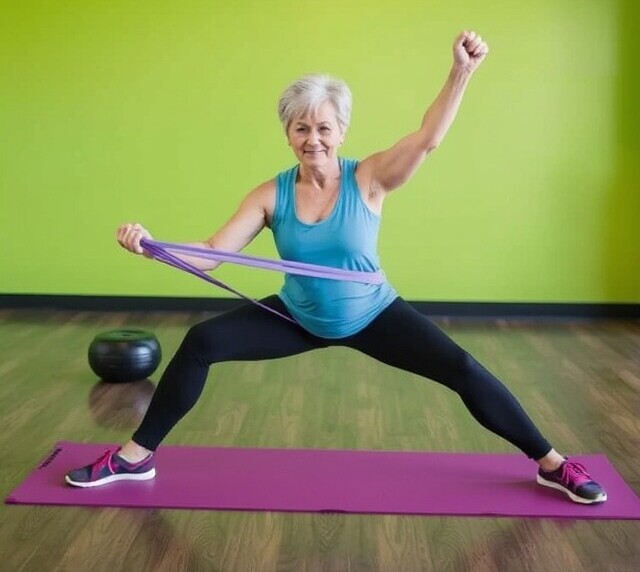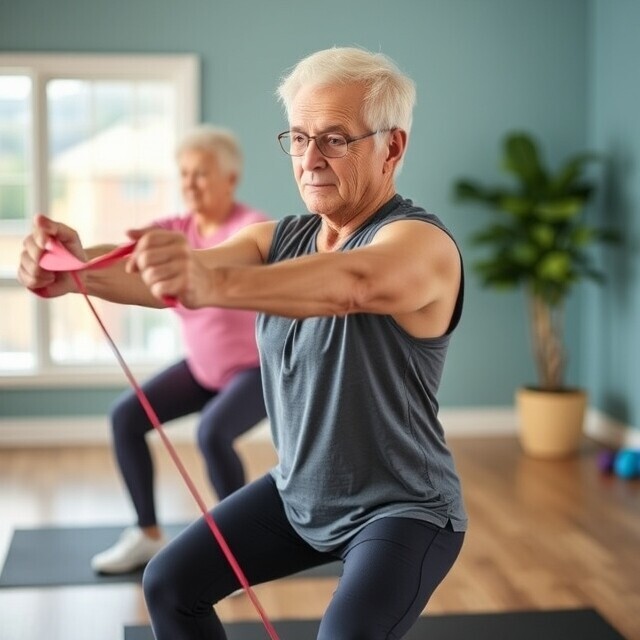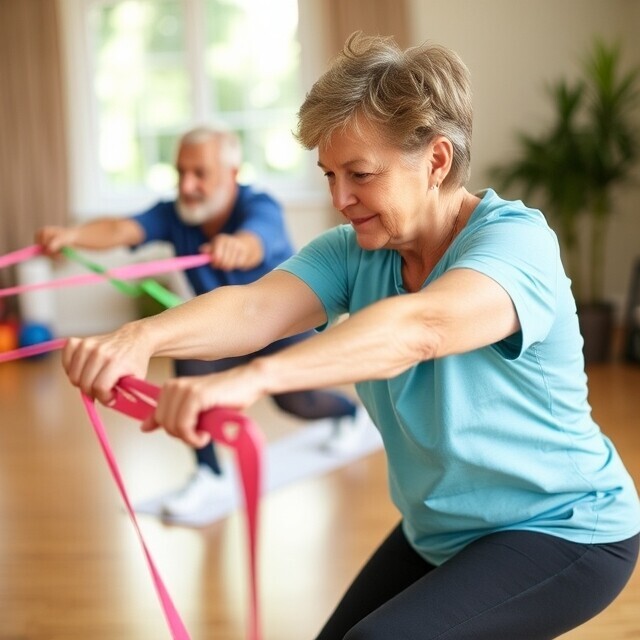
A friend of mine once said to me, “Getting old sucks”. He’s correct and it’s inevitable. But that means resistance bands for seniors, is for everyone. We will all become older and if we still have the urge to keep fit, we’re going to need some help.
Resistance bands might be exactly what you’ve been looking for, they can make any workout easy, yet effective. Whilst delivering a unstressed joint workout. Take a look at what I mean.
Resistance Bands For Seniors
A Gentle Path to Strength and Flexibility
Resistance bands have become a popular choice in the fitness world, especially among seniors. They’re versatile, portable, and most importantly, they offer a gentle yet effective way to strengthen muscles and maintain flexibility.
As we age, it becomes increasingly important to focus on activities that enhance mobility, balance, and overall functional fitness, and resistance bands fit perfectly into this scenario.
Why Resistance Bands Are Ideal for Seniors
One of the biggest advantages of using resistance bands is their ability to deliver effective workouts while reducing the risk of injury. Traditional weights can sometimes be risky for seniors, as they can strain joints or lead to accidents if not handled correctly.
Resistance bands, however, provide a low-impact alternative that still promotes muscle gain and flexibility. You can safely use them at home, in a gym, or even outdoors, offering great flexibility in workout locations.
Unlike bulky gym equipment, resistance bands are lightweight and compact, making them easy to store and carry. Their adaptability ensures they can be used by individuals at any fitness level. Seniors, in particular, can benefit from bands’ ability to target specific muscle groups with adjustable resistance, allowing for personalized workouts.

Benefits of Resistance Bands for Seniors’ Fitness Goals
Resistance bands offer several benefits tailored to the needs of seniors. Here’s why they are a standout choice:
- Improved Strength and Mobility: Regular use of resistance bands helps maintain muscle mass, which naturally declines with age. Strengthened muscles improve overall mobility and reduce the risk of falls.
- Enhanced Joint Health: The gentle resistance minimizes pressure on joints, making bands an excellent option for seniors with arthritis or similar conditions.
- Versatile Workouts: From seated exercises to standing routines, resistance bands can be used in countless ways to suit individual needs.
- Cost-Effective: They are affordable compared to gym memberships or heavy equipment, and a single set can last for years with proper care.
Resistance Bands For Seniors: Top Exercises to Build Strength and Flexibility
Incorporating resistance bands into a fitness routine is simple and rewarding. Here are some highly effective exercises tailored to seniors:
1. Seated Row
The seated row strengthens the upper back and shoulders while promoting good posture.
How to Perform:
- Sit on a sturdy chair.
- Loop the band around your feet and hold both ends with your hands.
- Pull the band towards your torso, mimicking a rowing motion, while keeping your elbows close to your body.
- Slowly return to the starting position and repeat.
2. Leg Press
This exercise builds leg strength and enhances mobility, reducing the risk of trips and falls.
How to Perform:
- Sit on a chair and loop the band around your feet.
- Hold the ends in your hands and press your legs forward until fully extended.
- Return to the starting position with control.
3. Band Pull-Apart
A fantastic exercise for chest and shoulder flexibility.
How to Perform:
- Hold the band with both hands, keeping your arms straight in front of you.
- Pull the band apart until it’s level with your chest.
- Slowly release to the starting position.
4. Overhead Press
Strengthen arms and shoulders for easier day-to-day movements like lifting or reaching.
How to Perform:
- Step on the band with both feet and hold the ends.
- Raise your arms above your head and slowly lower them.
- Perform while seated for additional stability if needed.
5. Side Leg Lifts
Great for hip and thigh strengthening, which supports better balance.
How to Perform:
- Place a loop band around both ankles.
- Hold onto a chair or wall for balance and lift one leg sideways, keeping it straight.
- Return to the starting position and switch sides.
These exercises, when performed consistently, can greatly enhance a senior’s strength, flexibility, and overall quality of life. Remember to start with lighter resistance and progress gradually.

Tips for Choosing the Best Resistance Bands For Seniors
Choosing the right resistance band ensures a safe and effective workout. Here are key considerations:
- Types of Bands:
-
- Loop Bands: Excellent for lower-body exercises like leg presses or side steps.
- Tube Bands with Handles: Useful for upper-body exercises such as rows or presses.
- Therapy Bands: Designed for rehabilitation, these are softer and ideal for beginners.
- Resistance Levels:
Bands are usually color-coded to indicate resistance. For seniors, light or medium resistance is a great starting point. - Quality and Durability:
Invest in bands made from high-quality materials. Look for non-slip surfaces and bands that resist snapping. - Maintenance:
To prolong the lifespan of your bands, store them in a cool, dry place and inspect them regularly for signs of wear.
Safety First: Best Practices for Using Resistance Bands For Seniors
To maximize the benefits of resistance bands while minimizing risks, keep these safety tips in mind:
- Warm-Up Before Exercise: A 5–10-minute warm-up with light stretching or walking can prepare your muscles and joints for exercise.
- Use Proper Form: Incorrect form can lead to strain or injury. Start slowly and focus on technique.
- Stay Consistent: Aim for short, regular sessions rather than sporadic intense workouts.
- Listen to Your Body: If an exercise feels uncomfortable or painful, stop immediately.
- Consult a Professional: For personalized guidance, consider consulting a fitness trainer or physical therapist familiar with resistance band exercises.
Frequently Asked Questions About Resistance Bands For Seniors
Q: Are resistance bands safe for seniors to use?
A: Yes, resistance bands are generally very safe for seniors when used correctly. They provide a low-impact way to strengthen muscles and improve flexibility without putting unnecessary strain on joints. Starting with light resistance and focusing on proper form can further enhance safety.
Q: How often should seniors exercise with resistance bands?
A: It’s recommended to start with 2–3 sessions per week, each lasting 20–30 minutes. As you build strength and confidence, you can increase the frequency or duration. Be sure to include rest days to allow your muscles to recover.
Q: Can resistance bands help with arthritis or joint pain?
A: Absolutely. Resistance bands are often recommended for people with arthritis because they provide a gentle way to strengthen the muscles around the joints, which can reduce pain and improve mobility. Choose light resistance bands and perform slow, controlled movements to avoid exacerbating pain.
Q: Do I need any other equipment to use resistance bands?
A: Not necessarily! Resistance bands alone are highly effective. However, some exercises might benefit from a sturdy chair, a yoga mat for floor exercises, or a door anchor (usually included with some bands) for additional workout options.
Q: What should I do if a resistance band snaps during use?
A: While high-quality bands are unlikely to snap, it’s important to inspect your bands regularly for signs of wear and tear. If a band breaks, stop using it immediately to avoid injury. Replace worn-out bands promptly and ensure you’re storing them properly to prevent deterioration.
Q: Are resistance band exercises effective for improving balance?
A: Yes, resistance band exercises can significantly improve balance by strengthening core and lower-body muscles. Exercises like leg presses, side leg lifts, and seated rows can enhance stability, reducing the risk of falls.
Q: Can seniors with limited mobility use resistance bands?
A: Definitely. Resistance bands are versatile enough to accommodate varying levels of mobility. Many exercises, like seated rows or leg presses, can be done while sitting, making them ideal for individuals with mobility challenges. A physical therapist or trainer can provide tailored guidance for your needs.

Q: How can I stay motivated to use resistance bands regularly?
A: To stay motivated:
- Set small, achievable goals (e.g., completing three sessions per week).
- Track your progress by noting how many repetitions you can do or how the resistance feels over time.
- Involve a workout buddy or join a group class designed for seniors.
- Celebrate milestones, like moving to a higher resistance level or feeling more energized in daily activities.
Conclusion: The Endless Potential of Resistance Bands For Seniors
Resistance bands are more than just a fitness tool, they’re a gateway to maintaining strength, flexibility, and independence well into later years. Their versatility, portability, and low-impact nature make them perfect for seniors looking to improve their physical health safely and effectively.
Whether you’re new to fitness or looking for a convenient way to stay active, incorporating resistance bands into your routine can bring transformative benefits. With proper care, the right exercises, and a commitment to consistency, resistance bands can truly enhance the quality of life for seniors.
Take care of yourself, your loved ones, share, re-post and enjoy. Please leave any questions or comments below. I will answer as soon as possible.
Ultimate Training Gear.






